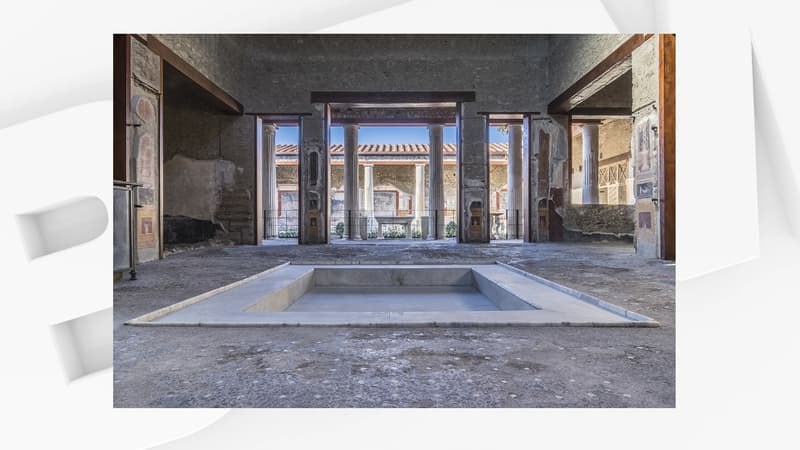Whether we give it its nickname “Sistine Chapel of Pompeii” or designate it by its real name, the observation is obvious: the “Vetti house” is both the jewel and the typical example of the habitat of this ancient old city. Located in southern Italy, it was left deserted after an eruption of Vesuvius in AD 79. C. before becoming in the modern era in one of the most impressive archaeological sites in the world.
However, the building is once again accessible to tourists who come to Pompeii, after 21 years of work -the restoration began in 2002- and this, since Tuesday.
The reopening, with much fanfare, was extensively filmed. For the occasion, it was the Minister of Culture, Gennaro Sangiuliano, who officiated the inauguration, showing the importance of the event for the leadership of the state.
A patio and frescoes
The photos and videos published by the archaeological site and the ministry allow you to admire the splendors of the place. At the heart of the estate we can see a courtyard, an outdoor garden, surrounded by columns and statues, near which Geo Also notice the bathtubs and marble tables.
But it’s still inside where the charm works best. Mythological or erotic scenes, mosaics… the walls are covered in frescoes. Furthermore, it is this exceptional art gallery that has earned the villa its nickname of the “Sistine Chapel”, in reference to the Vatican’s masterpiece.
the vetti
But why do we also talk about “Vetti’s house”? It is that the two men who resided there, were called Aulus Vettius Conviva and Aulus Vettius Restitutus, raises the site Fortune.
And his profile is in itself a window into his time: because if the experts think without much certainty that they were brothers, on the other hand they are almost certain that they were freed slaves later enriching themselves in the wine trade. Enrichment of which his house bears witness.
A journey that may seem surprising, but which is nevertheless emblematic of the relative fluidity of trajectories and situations in Roman society, at least that of his time according to the director of the archaeological site, Gabriel Zuchtriegel, quoted here by Geowhich has “a level of social mobility unthinkable two centuries ago”.
He still esteems, with Fortune this time, that the frescoes say a lot about the personality of the owners “by reflecting their dreams, their imagination and their anxieties as soon as they had chosen to live in the midst of these images.” Thus, she interprets the scene that exalts Hercules triumphing over the snakes sent by Juno to kill him in the cradle, on one of the walls, as an allegory of his social ascent.
A house that tells an even bigger story
Those in charge of Pompeii can be even more proud and contemplate these representations since they have been perfectly refreshed by the modern techniques used during these twenty years of work while the paraffin used in the previous reforms had succeeded in blurring their features.
Ariana Spinosa, the architect in charge of this restoration, is visibly happy with the result obtained, declaring -as here- that the “Vetti house” embodies “the house (house, Editor’s Note) Pompeian par excellence, not only for its exceptionally important frescoes, but also for its layout and architecture”.
She is a very good example of the fate of Pompeii in another aspect as well. In fact, it is thanks to the ashes that buried the place at the time of the eruption that the villa was preserved, CNN points out here, like the rest of the city.
If Pompeii is today an essential jewel in Campania and surely one of the best excavated soils by archaeologists, it has long since disappeared from the radar and from the memory of the people. Thus, after a few years of looting after the disaster, the city lived long and many centuries of oblivion. Until, in the mid-18th century, lucky pickaxes began to uncover the remains. The Vetti residence saw the light of day only at the end of the 19th century.
Source: BFM TV


